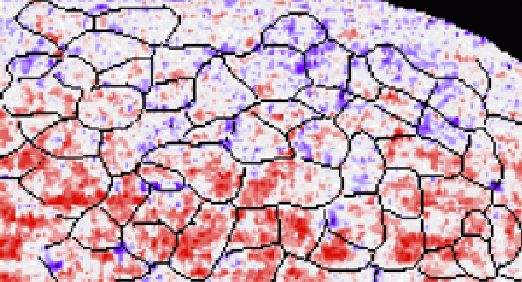Topics Include :-
- The Solar Wind
- Sun Layers
- The Solar Cycle
Is religion and science separable?
It seems that those that kept records of the stars mentioned in the Book of Cosmology are of the same class as those studying the information collected from space today to make predictions and explicate existence. Whether they are priests, historians or scientists, in absence of a prophet reality is interpreted and unless we pass beyond, it becomes our reality.
The sun remains (and is getting more and more) mysterious. So let's gain some knowledge of the sun.
We will also better understand issues like this one:
Adrian Gilbert and Maurice Cotterell, in their book the Mayan Prophecies, say that the end of the Great Cycle is the culmination of a series of what he claims are long-term sunspot cycles which will flip the sun's magnetic field, causing earthquakes and flooding on earth.

Graphs of real sunspot cycles do not predict a termination point at the end of the Great Cycle. But scientifically accepted records of sunspot activity do show that we are heading for a climax in the near future (as seen above in the trend of increasing maximum peaks over the years shown by the brown arrow].
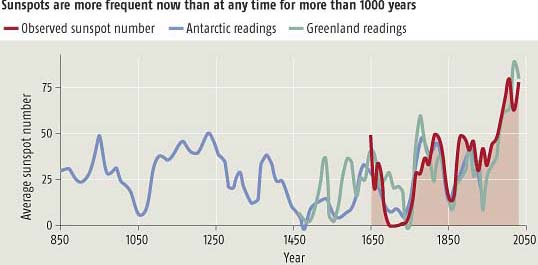
Sunspots are regarded as surface concentrations of the star's magnetic field and the more there are, the more energy the Sun is emitting. They have been recorded regularly since 1610.
Sunspot numbers are calculated from past levels of a radioactive isotope preserved in ice cores taken from Greenland and Antarctica which provide a record of the concentration of beryllium-10 in the atmosphere. This is produced when high-energy particles from space bombard the atmosphere, but when the Sun is active its magnetic field protects the Earth from these particles and levels of beryllium-10 are lower. Beryllium-10 is scarcer now than for a very long time.
There have been more sunspots since the 1940s than for the past 1150 years as shown in the graph. No period in the last 8000 years has been as active as the last 70. About 75 sunspots have appeared every year in this period, compared to an annual average of about 30 over the last 11,400 years. High activity periods only occurred for about 10% of the period studied, and tended to last for about three decades. This latest cycle has already lasted longer than most do.
The link between the Sun's magnetic activity and the Earth's climate is unclear and the contribution of the Sun to global warming is unknown. Carbon-14 studies of tree rings suggest patterns change on scales of 200 years.
Periodicity should be driven by the Sun, but the total energy emitted by the Sun actually changes by a relatively small amount as the number of sunspots varies.
Research will allow scientists to see if past climate changes are too large to be explained by the sunspot cycle alone. The current upsurge in sunspots is not enough to account for the approximate 0.5°C rise from pre-industrial temperatures over the last 30 years.
http://www.diagnosis2012.co.uk/1.htm
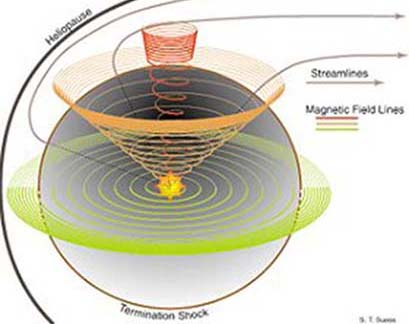
The Sun's magnetic field envelops the entire solar system in a bubble filled with a combination of gas, dust and plasma that scientists call the heliosphere. It is the region of space that is controlled by our star the sun and its magnetic field. It is theorised to extend from the sun out to approximately 100 A.U. (9,300,000,000 miles).
At the point that the solar wind ceases and interstellar space begins, is a boundary called the heliopause. Although the Sun is nearly a perfect sphere, the heliosphere is thought to be more slightly tear drop shaped, as seen from outside and above the solar system. This tear drop shape, is theorised to be caused by the solar systems' rotation around the center of our galaxy, the Milky Way. Where it meets the interstellar medium, on the front and pushing in on the outside of the heliosphere, is an area called the bow shock region.
Space vehicles in interplanetary space have encountered streams of highly energetic charged particles originating from the sun. These streams, called the solar wind, flow radially outward from the sun through the solar system and extend far beyond the orbit of Pluto. Although these particles are continuously released from the corona, their numbers increase greatly following solar flares. The particles travel about 250 miles per second.
Disturbances in the sun's magnetic field take about a year to propagate all the way from the Sun to the outer bounds of the heliosphere."
With a surface temperature of 5800 K, the Sun should normally emit no X-rays at all, and so should look completely dark on an X-ray image. Experience reveals that this is not the case. X-ray bright regions indicate heating to temperatures in excess of 2 million degrees Kelvin. The brightest X-ray emitting regions are almost always overlying sunspots or active regions.
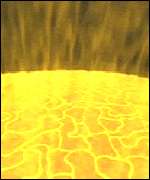 http://www.oulu.fi/~spaceweb/textbook/solarwind.htm
http://www.oulu.fi/~spaceweb/textbook/solarwind.htm
The sun also vibrates or pulses continually. It was discovered in 1962 that the sun is quivering or in a constant state of vibration. The Suns' surface heaves up and down in a regular fashion of oscillation periods ranging from 5 to 160-mins intervals with an amplitude of about three kilometers.
http://ourworld.compuserve.com/homepages/jbstoneking/jbspage6.htm
The solar wind comes from coronal holes but the stream begins at the edges of honeycomb-shaped patterns of magnetic fields at the surface of the Sun.
An important feature of plasma sheaths, or double layers, is that the electric field on either side of the thin double layer is very weak and the plasma there is ‘quasi neutral.’ That’s why we do not see evidence of a strong electric field from the charged Sun, and why the ‘solar wind’ appears to be electrically neutral. For this reason, the bulk movement and magnetic field of the ‘solar wind’ best signify the Sun’s electrical activity.
‘Marklund convection’ occurs along the discharge axis. It separates the chemical elements radially. Marklund convection causes helium to form a diffuse outer layer, followed by a hydrogen layer, then oxygen and nitrogen in the middle layers, and iron, silicon and magnesium in the inner layers. So electric stars should have a core of heavy elements and an upper atmosphere mostly of hydrogen.
Stars produce electrically in the high-energy electrical discharges of their photospheres all the elements required to form rocky planets. Nucleosynthesis of heavy elements does not require a supernova explosion.
EU proponents believe the photosphere of a star is an electric discharge high in its upper atmosphere that can be compared directly with low-pressure glow discharges in the lab. The spectrum of the photosphere reflects the star’s upper atmosphere composition, which is largely hydrogen. The heavy elements seen in the spectrum are produced right before our eyes in the photospheric discharge.
Measurements of stellar radii are misleading since the photosphere is a bright plasma ‘skin’ at great height in the atmosphere above the solid surface of the star. That height, in the case of the Sun, may be estimated simplistically as follows: the Sun has a mass equivalent to 333,000 Earths; if most of the mass of the Sun is in heavy elements similar to the Earth, the Sun would have a solid diameter somewhat less than 900,000 kilometers, compared to its optical diameter of 1.4 million kilometers. That suggests the photosphere is some 250,000 kilometers (155,343 miles) above the surface of the Sun.
There is a sun planet in the center of the photosphere, at a distance interior, from three thousand miles to thirty thousand miles, and it is light all the way around. But within the body of the photosphere there are numerous planets, some globular, some elongated and irregular. These are usually called sunspots; because when they present their negative surface [shadow side or cooler side] toward the earth they seem black. For the most part, these planets in the photosphere are rather external [near the outer edge of the photosphere] than internal at the times they appear as spots.
The chromosphere is the layer of the solar atmosphere located above the photosphere and beneath the transition region and the corona. It is hotter than the photosphere but not as hot as the corona.
The corona is the gaseous region above the surface that extends millions of miles into space. Thin and faint compared to the Sun' surface, the corona is only visible to the naked eye during a total solar eclipse. Temperatures in this region is 1 to 2 million Kelvin (1.8-3.6 million deg. F), 200 times hotter than the surface of the Sun.
How the corona can be so much hotter than the surface remains a mystery to scientists, but most suspect that it has to do with the complicated magnetic fields that burst from the interior and extend above the surface in great arches and loops.
Large flare events and bright areas on the surface don't continuously pump enough energy, or connect well enough to the corona to sustain the high temperature throughout the entire corona. Typical microflares are about the size of the Earth, and in their 5-minute lives release as much energy as 10 million H-bombs.
A recent answer is that the energy source is a continuous rumble of microflares, feeding magnetic energy into the corona. One microflare has only about 1 percent of the energy of a large, bright loop. But you have these cool microflares constantly going off. And that's supposedly enough to heat the corona.
http://www.carli.de/slideshow/slide1.php
 Decades of observations reveal a 10.8 year cyclic pattern (varying from 9 - 12.5 years).
Approximately every 11 years the sun's magnetic field changes its direction (typically occuring 3 years after sunspot minimum), and so the cycle is said to be 22 years. It is not known what causes this cycle, but two hypotheses have been proposed: -
Decades of observations reveal a 10.8 year cyclic pattern (varying from 9 - 12.5 years).
Approximately every 11 years the sun's magnetic field changes its direction (typically occuring 3 years after sunspot minimum), and so the cycle is said to be 22 years. It is not known what causes this cycle, but two hypotheses have been proposed: -
1) Magnetic fields within the Sun are stretched out and wound around the Sun by differential rotation. Differential rotation distorts and twists magnetic field lines. The twisted field lines break through the photosphere surface forming sunspot pairs. Eventually, the field lines break apart and sunspot activity decreases. The cycle starts again. The Sun's differential rotation with latitude can take a north-south oriented magnetic field line and wrap it once around the Sun in about 8 months.
2) Huge tubes of gas circle the sun's interior at high latitudes and begin to move toward the equator. When they roll against each other, they form spots. When they reach the equator, they break up and sunspots decline.
As the sun's magnetic field reverses it becomes disordered, and the sun's entire surface sprouts small, short-lived coronal holes and streamers. Profuse sunspots pepper the face of the Sun, eruptions and auroras are most active, and the magnetic field begins to change. This period of change is called solar maximum.
Bubbles of gas and energy called coronal mass ejections that shoot away from the sun in every direction are far more common around solar maximum. With the reversal of the magnetic field the sun's polar coronal holes shrink and ultimately disappear. The sun starts to form large polar coronal holes very soon after solar maximum.
The active region belts on either side of the equator resemble the backs of two undulating sea serpents that move parallel to the equator, creating bipolar sunspot pairs each time it loops through the surface.
The belts move inexorably towards the equator until the sunspots come together and disappear at the time of the minimum. Out of its destruction, the cycle emerges from the ashes like a phoenix and renews itself.
When the minimum is reached the bipolar sunspot magnets flip and turn around. Reversal does not occur simultaneously at opposite poles. One pole may change a year or two before the other, thus for a time the sun may have two north or south poles.
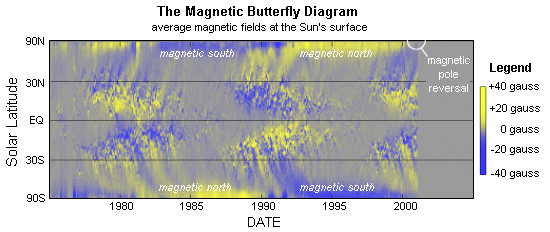 As the cycle proceeds from maximum to minimum the sunspot distribution drifts towards the equator with a pronounced North-South asymmetry in the hemispheric distributions (seen on a butterfly diagram).
As the cycle proceeds from maximum to minimum the sunspot distribution drifts towards the equator with a pronounced North-South asymmetry in the hemispheric distributions (seen on a butterfly diagram).
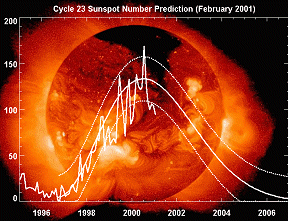
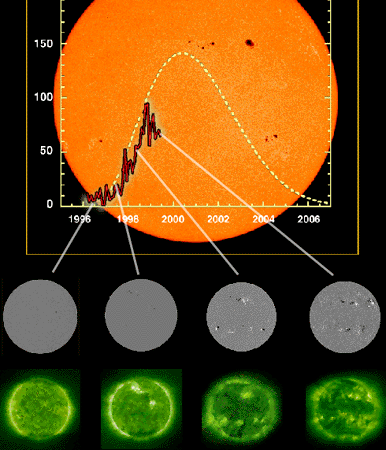
On February 15, 2001 the magnetic pole reversal took place at the peak of the sunspot cycle (see chart, left). The Sun's magnetic poles will remain as they are now, with the north magnetic pole pointing through the Sun's southern hemisphere, until the year 2012 when they will reverse again.
The diagram on the right shows sunspot activity increasing with the solar cycle. Magnetic fields of sunspots are visible in Magnetograms (grey). X-ray photos (green) make visible unseen electromagnetic activity in the corona. Notice how sunspot activity on the photosphere parrallels the x-ray activity in the corona and how the activity grows from minimum to maximum.
The proportions of the various constituents in the solar wind and the extent of their ionization (loss of electrons) are different in the slow and fast solar windstreams.
The high-speed wind originates in coronal holes, whereas the low-speed wind comes from dense coronal streamers that straddle magnetic neutral lines at the Sun, and that tend to be either equatorial (near solar minimum) or else lie along the streamer belts at intermediate latitudes.
During the declining and minimum phases of the solar cycle, the solar wind is dominated by high-speed flows (500-800 k/s) emanating from Coronal Holes -- regions of low coronal density and temperature where the magnetic field is weak and the field lines are open to interplanetary space. Coronal holes occur both at low latitudes and at the poles; the polar holes are largest at solar minimum, extending equatorward and often merging with low-latitude holes of the same magnetic field polarity.
"Meridional flows on the Sun's surface carry magnetic fields from mid-latitude sunspots to the Sun's poles. "The poles reverves because these flows transport south-pointing magnetic flux to the north magnetic pole, and north-pointing flux to the south magnetic pole." The dipole field steadily weakens as oppositely-directed flux accumulates at the Sun's poles until, at the height of solar maximum, the magnetic poles change polarity and begin to grow in a new direction.
The solar wind also has a denser low-speed (300 kilometers per second) component that carries a greater flux of particles and is associated with the equatorial coronal Streamer belt. Near the ecliptic, the high- and low-speed components form alternating streams in the solar wind flow, moving outward into interplanetary space in an Archimedean spiral.
In the ascending phase of the solar activity cycle and at solar maximum, the average solar wind speed slows, as the polar coronal holes shrink and disappear and the high-speed flows narrow and weaken. At the same time, the ambient solar wind flow is increasingly perturbed by coronal mass ejections.
Coming typically from the Sun's equatorial region, the slow windstream remains more concentrated than the fast wind, which spreads out to fill most of the heliosphere. Moreover, the slow wind is more effective in stripping electrons from the interstellar hydrogen.
The heliospheric chaos of solar maximum occupies a unique and rather short-lived portion of the solar cycle. The polar solar wind at maximum is slower and gustier than at other times. Soon after solar maximum, within a year, we already see a return to a predominantly fast solar wind at high latitudes.

The high and low speed streams alternately pass by the Earth as the Sun rotates. These wind speed variations buffet the Earth's magnetic field and can produce storms in the Earth's magnetosphere.
The high-speed streams overtake the slow-speed flows and create regions of enhanced density and magnetic field known as co-rotating interaction regions (CIRs). These compressed interstream regions play an important role in solar-terrestrial relations: when CIRs encounter the Earth, they trigger geomagnetic storms that recur with a 27-day periodicity, corresponding to the Sun's rotational period.
The processes that heat the corona to over one million degrees Kelvin, several hundred times the temperature of the Sun's visible surface, and those that accelerate the solar wind have not been established and represent major unresolved questions in space science.
Thermal conduction cannot account for the flow speeds observed in the high-speed solar wind, so non-thermal processes must play a role in solar wind acceleration.
